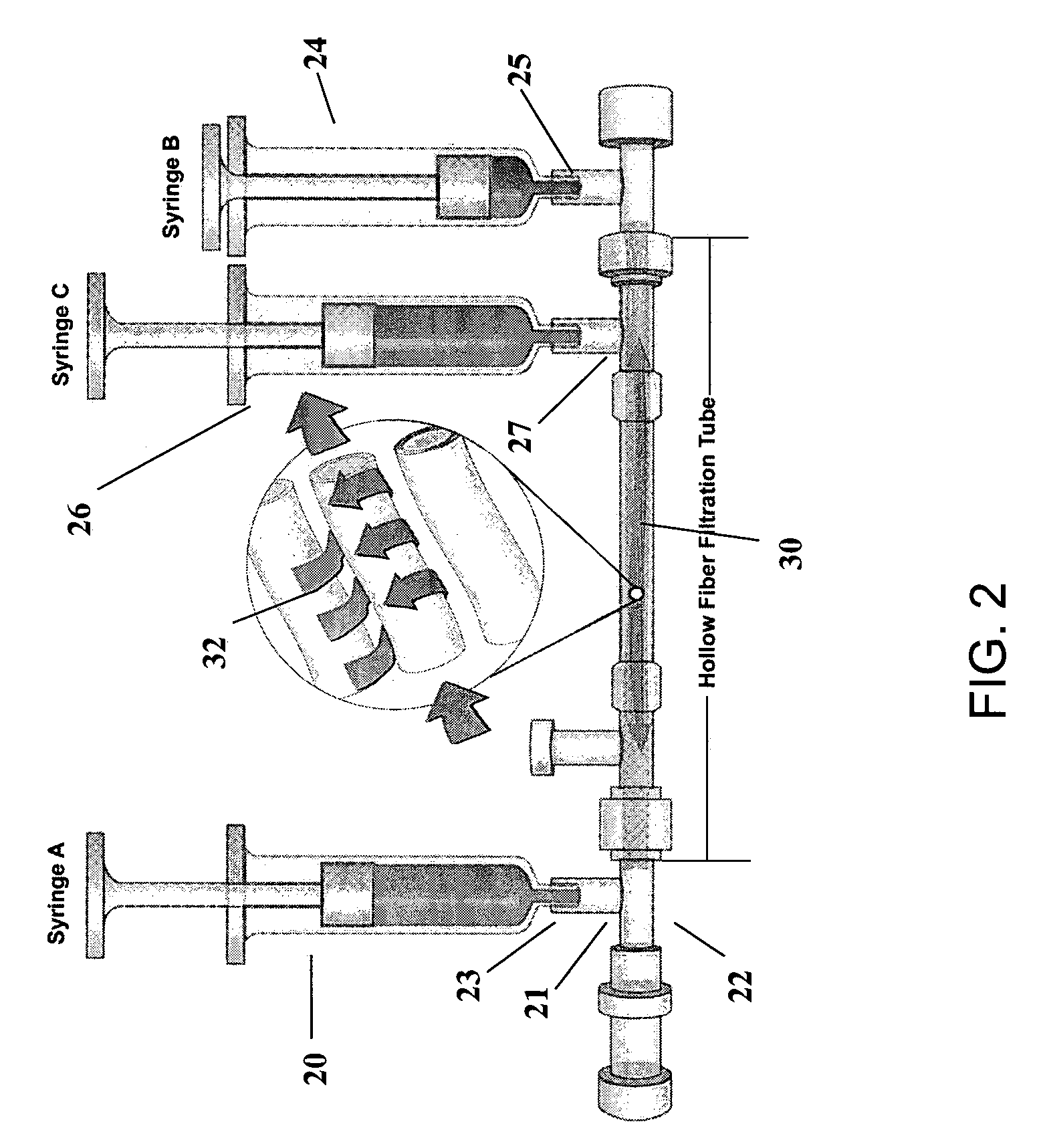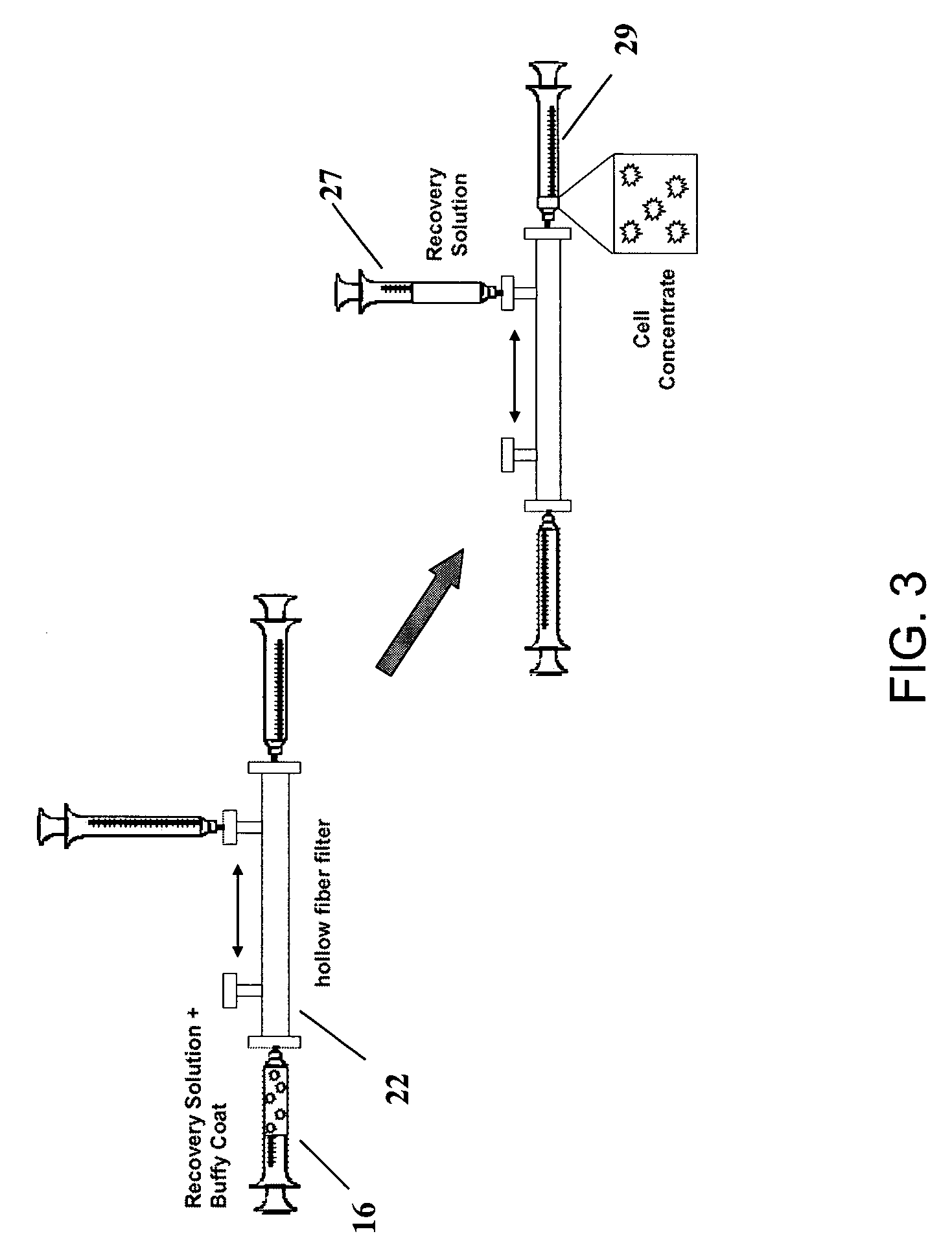Preparation of a cell concentrate from a physiological solution
a cell concentrate and physiological solution technology, applied in the field of bone marrow processing, bone therapy, medicine, etc., can solve the problems of not using concentrate in conjunction, unable to describe the methods and compositions of platelet enrichment, and difficulty in preparing cell-rich suspensions
- Summary
- Abstract
- Description
- Claims
- Application Information
AI Technical Summary
Benefits of technology
Problems solved by technology
Method used
Image
Examples
example 1
Dual Filtration of Physiological Solution
[0151]An in vitro study is performed to determine the efficacy of the filter device in concentrating nucleated cells, such as mesenchymal stem cells, and platelets within bone marrow aspirate, although in some embodiments blood or a mixture of blood and bone marrow may be utilized. A volume of the exemplary marrow aspirate, such as 25 mL, is procured from an animal donor(s) (such as, for example, sheep). Each sample is divided, wherein half the sample is not processed and half the sample is processed by the filtration device(s) described herein. The volume of the unprocessed sample (V0) and that of the sample after it has been processed (V1) is measured. Nucleated cell count, mesenchymal stem cell count, and platelet count is determined by hemocytometry and flow cytometry for each unprocessed and processed sample. Additionally, in order to quantify the concentration of mesenchymal stem cells that differentiate towards an osteoblastic lineage,...
example 2
Description of Exemplary Filter Configurations
[0153]Exemplary filter configurations in the present invention may be as follows:[0154]1. Leukofilter only (see FIG. 4);[0155]2. Leukofilter+Hollow Fiber Filter (Cross-flow mode) (see FIGS. 4, 5, 6);[0156]3. Leukofilter+Hollow Fiber Filter (Dead end mode) (see FIGS. 4, 7, 8); and / or[0157]4. Use of a Fat Reduction Filter with any of the above three configurations (FIG. 9).
[0158]In FIGS. 4A-4D, there is a schematic showing operation of a sole (or first, as in some embodiments described below) filter (such as a leukocyte reduction-type filter), to selectively recover osteogenic cells (i.e. platelets and nucleated cells) from a physiological solution. In the Fill step (FIG. 4A), a physiological solution comprising both osteogenic and non-osteogenic cells and optionally comprising anticoagulant is injected into a collection bag 10. In a filtration step (FIG. 4B), the physiological solution passes from the collection bag 10 through the leukocy...
example 3
Description of Cell Concentrate Characteristics
[0161]In a particular embodiment of the present invention, the final cell concentrate must have at least one of the following characteristics: 1) nucleated cells per unit volume greater than in the starting physiological solution; 2) platelets per unit volume greater than in the starting physiological solution; and / or 3) upon activation of platelets, the concentration of growth factors is greater than that of an equivalent volume of the starting physiological solution. Examples of growth factors are platelet-derived growth factor (PDGF), transforming growth factor beta (TGF-β), vascular endothelial growth factor (VEGF), epithelial growth factor (EGF), and insulin-like growth factor (IGF).
[0162]In particular embodiments, the method to obtain the cell concentrate and / or the cell concentrate itself may have the following attributes: 1) leukocyte concentration of at least about six times that of baseline blood value; 2) substantially no exo...
PUM
| Property | Measurement | Unit |
|---|---|---|
| molecular weight | aaaaa | aaaaa |
| pore size | aaaaa | aaaaa |
| pore size | aaaaa | aaaaa |
Abstract
Description
Claims
Application Information
 Login to View More
Login to View More - R&D
- Intellectual Property
- Life Sciences
- Materials
- Tech Scout
- Unparalleled Data Quality
- Higher Quality Content
- 60% Fewer Hallucinations
Browse by: Latest US Patents, China's latest patents, Technical Efficacy Thesaurus, Application Domain, Technology Topic, Popular Technical Reports.
© 2025 PatSnap. All rights reserved.Legal|Privacy policy|Modern Slavery Act Transparency Statement|Sitemap|About US| Contact US: help@patsnap.com



